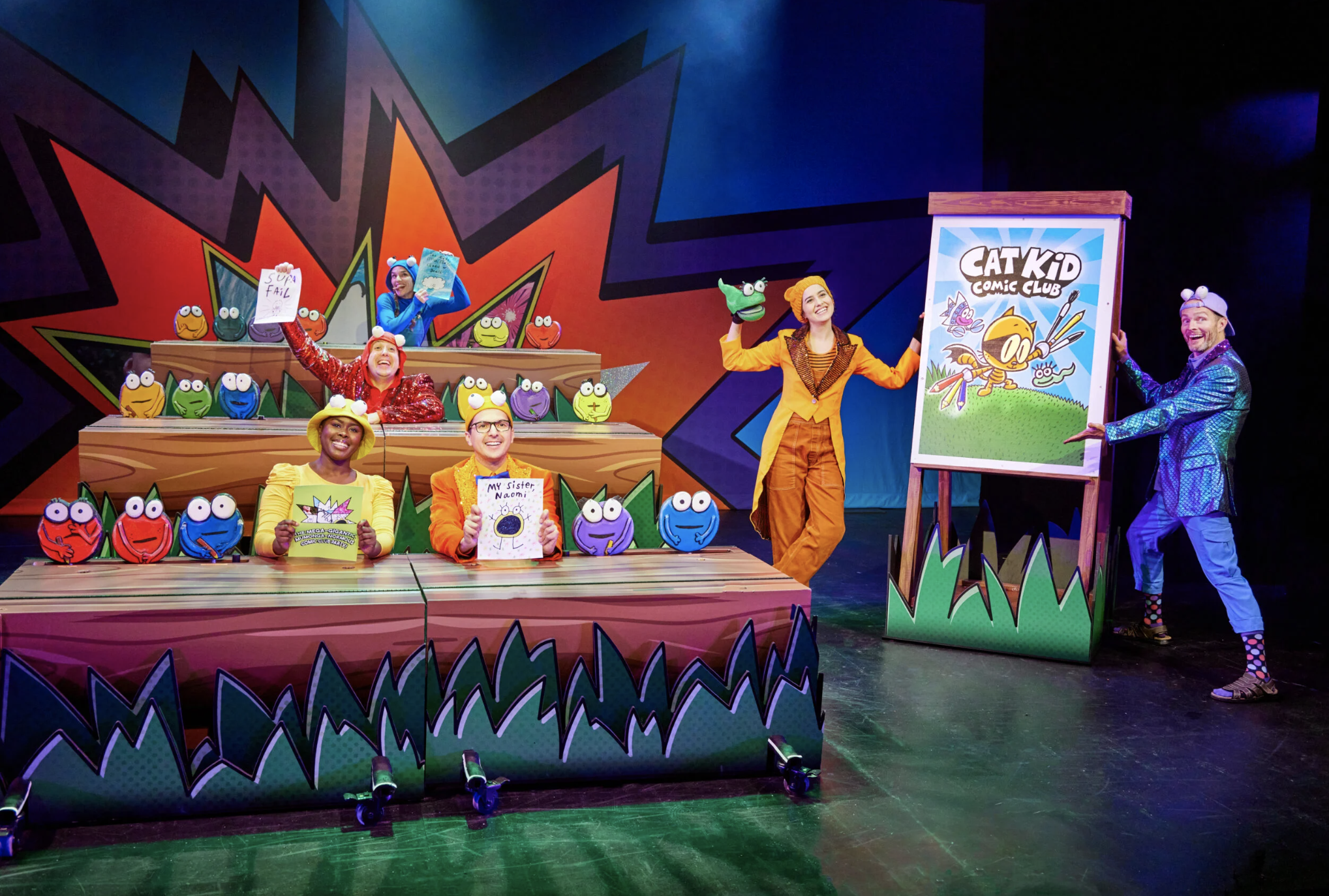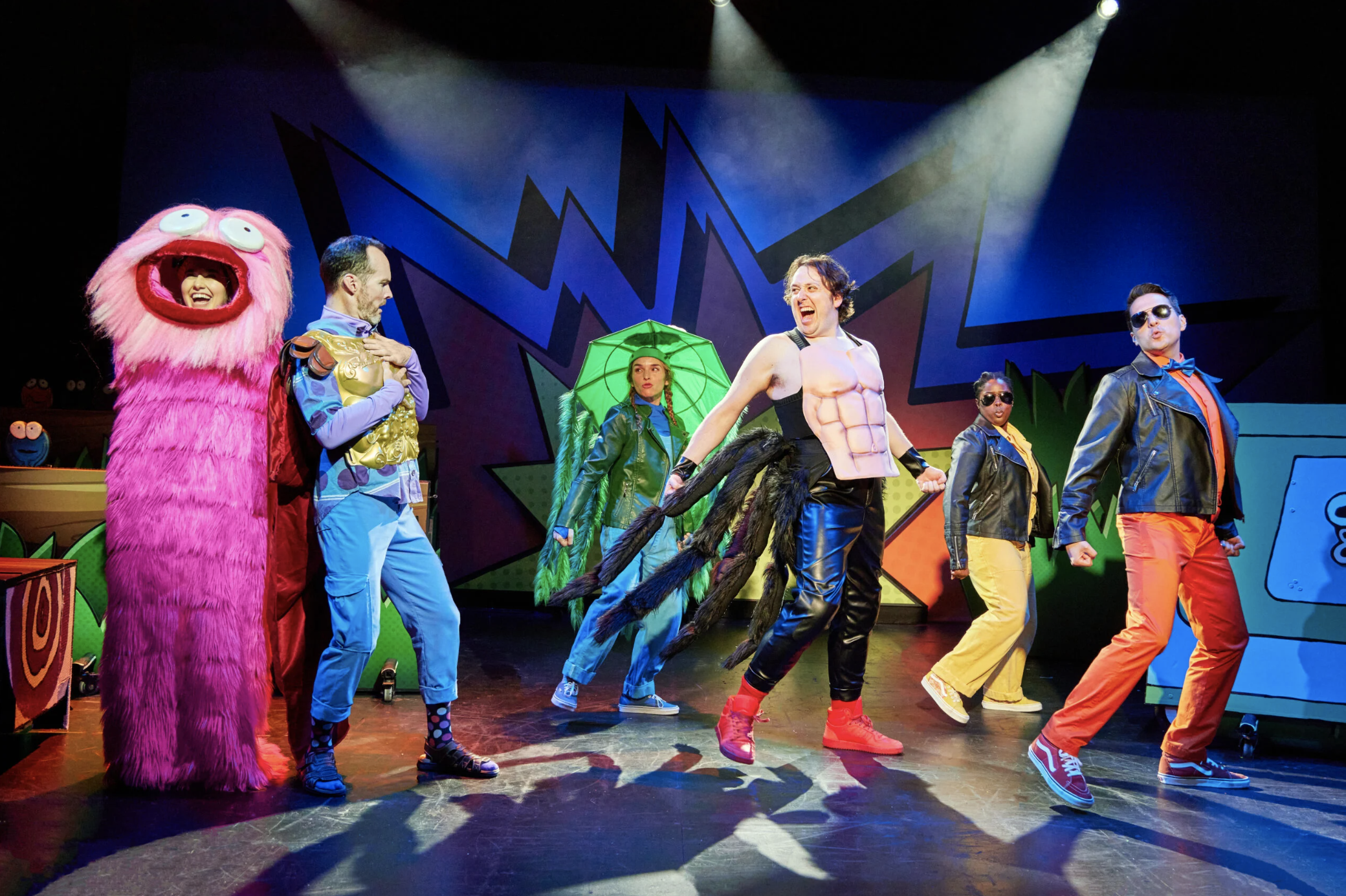Colorful Production Makes Fun Look Simple
Review of Cat Kid Comic Club at Seattle Children's Theatre
Written by TeenTix Newsroom Writer MANU SUAREZ and edited by Teen Editorial Staff member KYLE GERSTEL

Do you remember how you saw the world as a kid? For me and my overactive imagination, the world was so big and full of possibility—yet things were so much simpler. As soon as I walked into Seattle Children’s Theatre (SCT) with my family, TheaterWorksUSA’s musical adaptation of Cat Kid Comic Club took me back to that vibrant simplicity.
When I was around six years old, my favorite book series was Captain Underpants. Upon first discovery, the memorable characters, irreverent humor, and innovative page-flipping fight scenes had me captivated, and after begging my parents to buy it for me, I read the book cover-to-cover… and then I immediately reread it two more times.
As I grew, so did the Captain Underpants franchise, leading to spin-offs like Dog Man and, more recently, the Cat Kid Comic Club series. I had outgrown the series by then, but my younger brother and sister picked up where I left off. So naturally, when we found out about the release of a Cat Kid musical, seeing it was a no-brainer. I was curious how the scribbly comic-book action would translate to a staged performance, let alone one with frequent musical numbers. To the delight of my inner child, the show leveraged its auditory and musical elements to bring out the spirit of the source material.
SCT’s Charlotte Martin Theatre feels cozy but not cramped. I immediately took note of the laughter, chatter, and sniffling that surrounded me. I was wading in a sea of children, no taller than my midsection. Families curious about the show are sure to feel welcomed by both the kiddy environment and the warm staff who work there.

The first thing I noticed about the production was that simplicity was key. The set (designed by Cameron Anderson) consisted of just a few big blocks that could be arranged in many ways, from lecture-hall-esque rows of seats to burning cities. Any props were cartoon cutouts faithful to the artistic style of the book. I enjoyed how the style of props changed to black-and-white to indicate that the characters were inside of a comic; the cardboard sound-bubbles worked perfectly to capture the premise, especially when partnered with audio effects that couldn’t be expressed in the original comic. In contrast to the wacky props, the base costumes (by Jen Caprio) left some expressiveness to be desired. For such a whimsical cast of main characters—Cat Kid the anthropomorphic cat (Janna Linae), Flippy the cyborg fish (David Vandyke), and a class of formerly-psychic frogs—the costume representations felt somewhat bland in comparison, consisting of colored jumpsuits or overalls and hats with googly eyes. I honestly forgot that the characters were cartoon animals and not humans. Ironically, the human characters had the costumes that I felt best captured the spirit of the book, but they only appeared in the opening and closing numbers of the show.
The decision to reduce the flashiness of the base costumes, while admittedly disappointing at times, made the costume changes in the songs all the more effective. The musical numbers focused on bringing to life the comic books created by frog children in an attempt to give the frog kids an outlet. As a result, the premises of each song are completely absurd, allowing designer Jen Caprio to shine with some excellently zany costumes. While the jokes are obviously written for children, showcasing author Dav Pilkey’s patented potty humor, I was blown away by the commitment to their delivery. Each actor completely took on their role, passionately belting about the likes of toothbrush lawyers and radioactive spider-butts.
I was particularly impressed with the actor of Kip the Frog (Jimmy Henderson), whose stellar vocal performance is a major reason some of the songs are still stuck in the heads of my entire family. Despite the immature themes, the quality of lyrics by Kevin Del Aguila and music by Brad Alexander surprised me. As a musician myself, I was inspired by the way the songs didn’t feel like they were restricted by the silly concepts. I felt that the creators recognized that children can appreciate art and expression just as well as anyone else can. This goes perfectly with the story of the show, one that celebrates unique perspectives and the way art can bring them together.

Beyond the humor, I found the core relationship between main characters Naomi (Diamond Destiny) and Melvin (Jeremy Fuentes) to be endearing, as it reminded me of my younger sister and brother. As I grow older, I find myself seemingly more and more detached from my siblings, but this show reminded me that sometimes, I just need to see the world from their eyes. And if nothing else, there is something irresistibly hilarious about grown adults refusing to break character as they sing about the story of a toothbrush traveling back to the Jurassic to be a defense attorney for an iguanodon.
Watching the show, I found myself delighted time and time again by the evident care the writers and actors had for children, and I can see how determined they were to bring such a beloved series to life. In true Dav Pilkey fashion, the show never talked down to children but instead lifted their voices up. I’m grateful for the chance Cat Kid Comic Club gave me to be a kid again.
Lead photo by Jeremy Daniel.
The TeenTix Newsroom is a group of teen writers led by the Teen Editorial Staff. For each review, Newsroom writers work individually with a teen editor to polish their writing for publication. The Teen Editorial Staff is made up of 6 teens who curate the review portion of the TeenTix blog. More information about the Teen Editorial Staff can be found HERE.
The TeenTix Press Corps promotes critical thinking, communication, and information literacy through criticism and journalism practice for teens. For more information about the Press Corps program see HERE.

